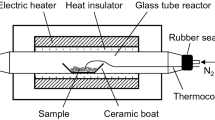Abstract
Chemical reactivity of heat-treated wood was compared with that of untreated wood. For this purpose, heat-treated pine or beech sawdust was reacted with different carboxylic acid anhydrides in pyridine or with phenyl isocyanate in dimethyl formamide. Compared to controls, weight gains obtained with heat-treated sawdust are smaller showing a lower chemical reactivity. FTIR analyses of lignin and holocellulose fractions, isolated after acidic hydrolysis of polysaccharides or delignification with sodium chlorite, indicate that both components are involved in the reactions. Compared to lignin, holocellulose exhibits important infrared absorptions of about 1,730 cm−1, characteristic of ester or urethane linkages formed. Lower reactivity of heat-treated sawdust is explained by the decrease in free reactive hydroxyl groups in holocellulose due to the thermal degradation of hemicelluloses, considered more reactive than cellulose.




Similar content being viewed by others
References
Banks WB, Din RH, Owen N (1995) Fibre activation and subsequent copolymerisation. Holzforschung 49:104–108
Cardias Williams F, Hale MD (2003) The resistance of wood chemically modified with isocyanates: the role of moisture content in decay suppression. Int Biodeterior Biodegrad 52:215–221
Chang H, Chang S (2002) Moisture excluding efficiency and dimensional stability of wood improved by acylation. Bioresour Technol 85:201–204
Dawson BSW, Franich RA, Kroese HW, Steward D (1999) Reactivity of radiate pine sapwood towards carboxylic acid anhydrides. Holzforschung 53:195–198
Efanov MV (2001) Transformations of aspen wood and its principal components by O-acylation. Chem Nat Compd 37(5):482–485
Ellis WD, Rowell RM (1984) Reaction of isocyanates with southern pine wood to improve dimensional stability and decay resistance. Wood Fiber Sci 16(3):349–356
Frihart CR (2005) Wood adhesion and adhesive. In: Rowell RM (ed) Handbook of wood chemistry and wood composites, pp 257–260. ISBN 0-8493-1588-3
Gauthier R, Joly C, Coupas AC, Gauthier H, Escoubes M (1998) Interfaces in polyolefin/cellulosic fiber composites: chemical coupling, morphology, correlation with adhesion and aging in moisture. Polym Compos 19(3):287–300
Geay M, Marchetti V, Clément A, Loubinoux B, Gérardin P (2000) Decontamination of synthetic solutions containing heavy metals using chemically modified sawdust bearing polyacrylic acid chains. J Wood Sci 46(4):331–336
Gosselink RJA, Krosse AMA, van der Putten JC, van der Kolk JC, de Klerk-Engels B, van Dam JEG (2004) Wood preservation by low-temperature carbonisation. Ind Crops Prod 19:3–12
Hakkou M, Pétrissans M, Zoulalian A, Gérardin P (2005) Investigation of wood wettability changes during heat treatment on the basis of chemical analysis. Polym Degrad Stabil 89:1–5
Hill CAS, Cetin NS (1999) Surface activation of wood for grafting polymerisation. Int J Adhes 20:71–76
Hill CAS, Jones D, Strickland G, Cetin NS (1998) Kinetic and mechanistic aspects of the acetylation of wood with acetic anhydride. Holzforschung 52(6):623–629
Kalnins MA (1982) Chemical modification of wood for improved decay resistance. Wood Sci 13(4):202–208
Kamdem DP, Pizzi A, Jermannaud A (2002) Durability of heat-treated wood. Holz Roh Werkst 60:1–6
Lu JZ, Wu Q, McNabb HS Jr (2000) Chemical coupling in wood fiber and polymer composites: a review of coupling agents and treatments. Wood Fiber Sci 32(1):88–104
Marchetti V, Clément A, Gérardin P, Loubinoux B (2000) Synthesis and use of esterified sawdusts bearing carboxyl group for removal cadmium(II) from water. Wood Sci Technol 34:167–173
Militz H (2002) Thermal treatment of wood: European processes and their background. The International Research Group on Wood Preservation, Document no. IRG/WP 02-40241
Nuopponen M, Vuorinen T, Jasma S, Viitaniemi P (2004) Thermal modifications in softwood studied by FT-IR and UV resonance Raman spectroscopies. J Wood Chem Technol 24(1):13–26
Pandey KK (1999) A study of chemical structure of soft and hardwood and wood polymers by FTIR spectroscopy. J Appl Polym Sci 71:1969–1975
Papadopoulos AN, Hill CAS, Traboulay E, Hague JRB (2002) Isocyanate resins for particleboard: PMDI vs EMDI. Holz Roh Werkst 60:81–83
Patzelt M, Stingl R, Teischinger A (2002) Termische Modifikation von Holz und deren Einfluβ auf ausgewählte Holzeigenschaften. In: Modifiziertes Holz Eigenschaften und Märkte, Lignovisionen Band 3, 101–149. ISBN 1681-2808
Petrissans M, Gérardin P, Elbakali D, Serraj M (2003) Wettability of heat-treated wood. Holzforschung 57:301–307
Quillin DT, Caulfield DF, Koutsky JA (1992) Cellulose/polypropylene composites: the use of AKD and ASA sizes as compatibilizers. Int J Polym Mater 17:215–227
Quinney RF, Banks WB (1995) The activation of wood fibre for thermoplastic coupling, the reaction of wood with a potential coupling agent. J Wood Chem Technol 15(4):529–544
Rowell RM (1980) Distribution of reacted chemicals in southern pine modified with methyl isocyanate. Wood Sci 13(2):102–110
Rowell RM (1982) Distribution of acetyl groups in southern pine reacted with acetic anhydride. Wood Sci 15(2):172–182
Rowell RM, Simonson R, Hess S, Plackett DV, Cronshaw D, Dunningham E (1994) Acetyl distribution in acetylated whole wood and reactivity of isolated wood cell-wall components to acetic anhydride. Wood Fiber Sci 26(1):11–18
Rozman HD, Kumar RN, Abdul Khalil HPS, Abusamah A, Abu R (1997) Chemical modification of wood with maleic anhydride and subsequent copolymerisation with diallyl phthalate. J Wood Chem Technol 17(4):419–433
Sivonen H, Maunu SL, Sundholm F, Jämsa S, Viitaniemi P (2002) Magnetic resonance studies of thermally modified wood. Holzforschung 56:648–654
Stefke B, Hinterstoisser B (2002) Acetylierung von Holz. In: Lignovisionen: Modifiziertes olz Eigenschaften und Märkte, Modified wood properties and markets. Holzwirtschaft an der Universität für Bodenkultur, 25–55. ISSN 1681-2808
Tjeerdsma BF, Boonstra M, Pizzi A, Tekely P, Militz H (1998) Characterisation of thermally modified wood: molecular reasons for wood performance improvement. Holz Roh Werkst 56:149–153
Weiland JJ, Guyonnet R (2003) Study of chemical modifications and fungi degradation of thermally modified wood using DRIFT spectroscopy. Holz Roh Werkst 61:216–220
Wikberg H, Maunu SL (2004) Characterisation of thermally modified hard- and softwoods by 13C CPMAS NMR. Carbohydr Polym 58:461–456
Author information
Authors and Affiliations
Corresponding author
Rights and permissions
About this article
Cite this article
Nguila Inari, G., Petrissans, M. & Gerardin, P. Chemical reactivity of heat-treated wood . Wood Sci Technol 41, 157–168 (2007). https://doi.org/10.1007/s00226-006-0092-7
Received:
Published:
Issue Date:
DOI: https://doi.org/10.1007/s00226-006-0092-7




